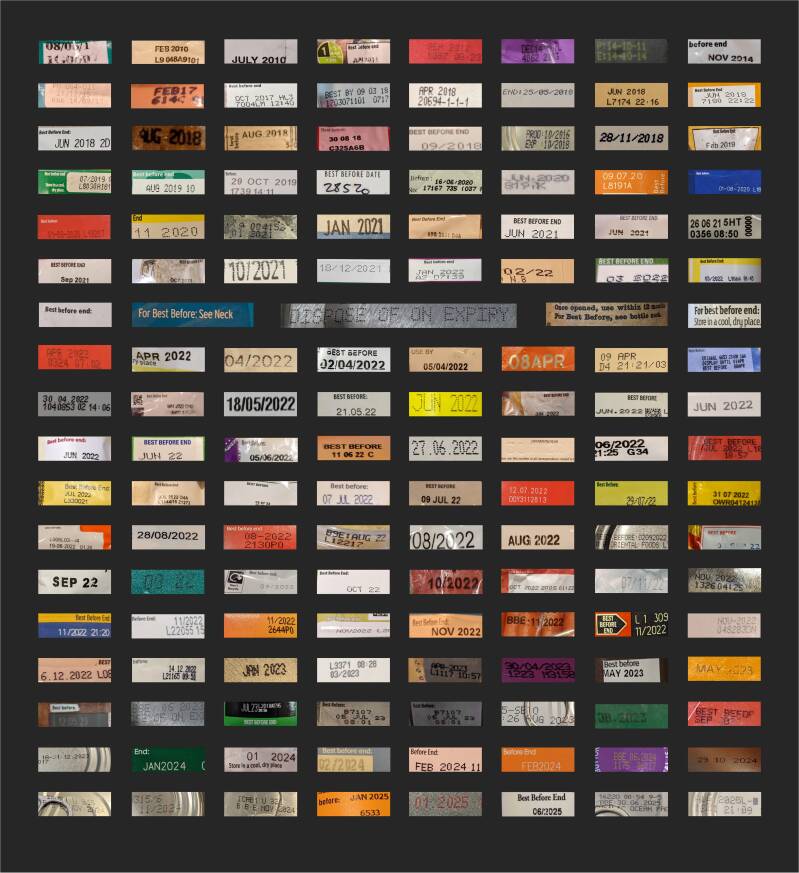
Apron
A piece of clothing worn over the front of other clothes to keep them clean while doing something dirty like cooking or cleaning.
Aprons have a long history having been worn by the ancient Pharaohs and Assyrian priests. The Aegean Snake Goddess, discovered at the Temple Repositories of Knossos in Crete, wears an apron and dates from circa 1600BCE. The apron became a domestic symbol in the Middle Ages being associated with homemakers, workers and artists. Over time it came to be symbolic of family, the stay-at-home mum, the 'domestic goddess'.
Best Before
Best before dates indicate when a food's quality may start to deteriorate, but these foods are usually still safe to eat.
Highly perishable foods are required to display use by dates in the UK, many of these foods are still perfectly edible after this date if common sense is used to check the appearance and smell first.
UK law does not enforce the use of best before dates yet most food labels include them. Many people throw food away that is past the best before date. According to WRAP's (Waste and Resources Action Programme) latest report 9.5million tonnes of food waste was produced in the UK in 2018, they estimate that 6.5 million tonnes of this was edible.
M&S can be held responsible for best before dates, introducing them in their stockrooms in the 50s and then onto shop shelves in the 1970s. Interestingly, it is speculated that Al Capone popularised the use of expiration dates on milk in the US after a family member became ill from drinking off milk. It is rumoured that the infamous gangster bought up a milk plant and lobbied Chicago city council to pass a law on labelling!
Cutlery
Referring to handheld implements used in the consumption of food. May be known as flatware in America.
Since Georgian times knives, forks and spoons were used together across Europe. However, the use of these is not universal. Many Asian countries predominantly use chopsticks and spoons and some African and Indian cultures eat with their hands or use bread to scoop up food.
In the novel I Capture the Castle (by Dodie Smith) Cassandra questions an American friend about the way he is using his cutlery. "It appears that in America it is polite to cut up each mouthful, lay down the knife on your plate, change your fork from the left to the right hand, and pick up the knife again...and you must only take one type of food on the fork at a time; never a nice comfortable wodge of meat and vegetables together."
Some people hold preferences about the cutlery they use, for example members of my family have been known to argue over the smallest teaspoon to eat their pudding with at family gatherings. I ask for a teaspoon to eat my dessert with in restaurants, it just tastes better off a tiny spoon.
If you so wish you could combine your cutlery by buying a spork, a spife or a knork.
#dinner
Photographs of food are huge on social media. It is the most photographed subject on Instagram.
As of May 2022 there were over 118 million #dinner posts alone regardless of other food related hashtags. But why so popular? A recent study in the Journal of Consumer Marketing reported that taking and posting a picture of your dinner can actually make it taste better! It can pay well too - the most successful foodstagrammers (with over 1 million followers) can expect to earn over £500 for each post.
Enamelware
Kitchenware coated in enamel, created by fusing powdered glass to a metal base resulting in a smooth, non-porous, non-stick finish.
Enamel was used in jewellery and art for centuries before it's properties started to be utilised for kitchenware in the 18th century. Through researching vintage enamelware for the archive I have discovered it is potentially dangerous as there were no regulations around the use of toxic metals - uh oh I've been using these items that belonged to my Granny Dot for years.
My Granny Dot is tied up in these inherited objects. In 1977 Minaly Csikszentmihaly (famous as the proposer of the theory of flow) and Eugene Rochberg-Halton surveyed families in Illinois about the domestic objects they cherished to inform their 1981 book The Meaning of Things. They concluded that happier, more 'authentic' people held value in objects for the social relationships represented therein rather than their material worth, and that people who value things also value people.




Create Your Own Website With Webador